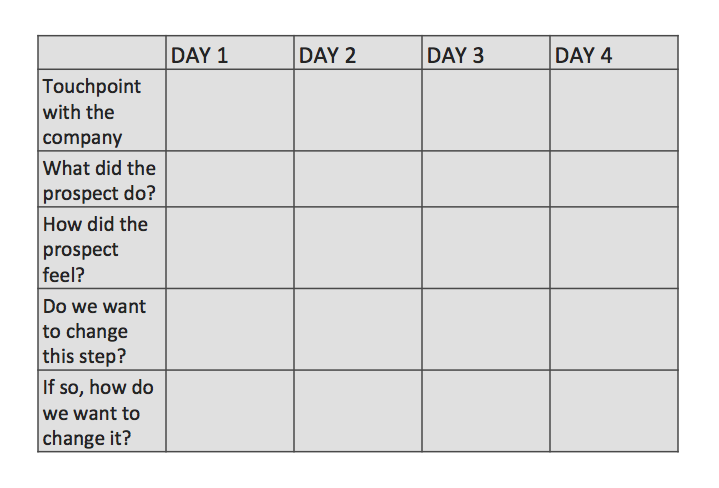Customer journey mapping is the marketing activity that visually represents the customer or prospect experience, touchpoint by touchpoint, toward a buying action and beyond. The customer journey map becomes a blueprint for marketers to review customers’ movements from start to finish, as they move in and out of online company connection. Piecing everything together highlights the obstacles, pain points, and motivations in the customer journey. The idea is to keep the customer experience journey on track and registering customer satisfaction. However, if it derails temporarily or permanently, we should know why to build a reliable source of reference for future customer journey mapping efforts.
Customer journey mapping and customer touchpoints
Customer touchpoints hold the answers to why some customer experience journeys are successful and others not. Each touchpoint standing alone helps little, even though the piece of information may look unusual. When we link them like a chain in a customer journey map, trends, and behavior patterns pop out. When customer journey maps show similar stops and starts, ups and downs, and customer reactions, they provide a more accurate look at the average customer journey. Another way of describing a customer journey map is that it’s a birds-eye view of the entire customer experience from the first move to after purchase use.
Erasing disruptive touchpoints, enhancing engaging ones, and restructuring the process to bypass obstacles are compelling benefits that emerge from the customer journey mapping exercise. Getting your string of touchpoints in order, thus bypassing unnecessary interference is a common management objective in modern marketing circles.
Customer journey mapping is a complicated arena. That’s because respondents don’t move through it in a one-dimensional way. It’s quite common for prospects to follow a zig-zag route, the following being a good example:
- Customers go online, navigating the website, jumping from the homepage to the services page to customer reviews, then logging off only to return later with a different search.
- In between, they go into the brick-and-mortar store to touch and feel but not buy.
- Back to the web site, this time to chat online with a customer service agent. Questions, recorded for reference, indicate more interest.
- Feedback prompts follow all customer connections, sometimes with a response and often not.
And so it goes, until eventually we see a purchase or the prospect disappears. We may note that many failed customer journeys abort at around the same touchpoints. On the other hand, it’s encouraging to see that specific touchpoints energize the customer journey forward toward the buying cart. A customer journey map is a proven methodology for picking up all this information. There are are two rules when it comes to a customer journey map:
- It must be visual
- It must make sense to the customer journey map users.
Why is mapping customer experience journey important?
Everything involved in customer journey mapping builds around making the customer experience (CX) engaging, smooth, and thoroughly satisfying. If you achieve these lofty goals, you’ll probably discover that customers seek you out more and more, a far more lucrative trend than outbound marketing. Customer journey maps develop marketing content for your prospects and customers that is meaningful and generates interest. It’s all about selling to them the way they want to buy and entering the conversation at the right time, with a message that genuinely resonates with interested parties. Remove customer journey maps from the equation, and on this level, at least, you’re shooting in the dark. Generalized, untargeted prospect fishing expeditions have little chance in the digital era where sophisticated customer behavior is the order of the day.
Customer journey maps contain insightful information about customer frustrations, hesitancies, distrust, aspirations, expectations, and language that no other methodology can provide. By tracking a sequence of customer touchpoints with the company, a picture emerges. With it comes anticipation and the ability to remove obstructions.
Losing customers to competitors is a huge cost for any business. When one thinks of the investment in getting a customer to the buying cart only once, the mind boggles:
- How many Facebook or Google clicks went by until a prospect became a subscriber?
- How many radio ads, billboard posters, TV commercials, and customer service hours did you invest in to turn a new prospect into a new customer?
Customer churn is the arch-enemy of profitability, whereas customer retention is its friend. The path to take is obvious, and customer journey mapping is the torch that lights the way.
Any marketer that isn’t 100% focused on resolving customer pain is doomed to fail. The “open sesame” to customer pain lies somewhere in the touchpoints. Customer journey mapping is integral to recording all of them and finding a way to paint the picture (i.e., visualization).
Creating a customer journey and the customer journey mapping tools that work best
Professional customer journey mapping consultants like Sogolytics help you structure the data sheets that connect customer touchpoints to their emotions, thinking, and actions. There are standardized and customizable templates sitting in their resource pool, ready for marketers to access. It may be as simple as an Excel table with time on the horizontal and constructs as follows:

Customer journey mapping is so advanced these days, there’s no point in reinventing the wheel. We recommend contacting Sogolytics and other expert entities to begin getting in touch with your customers’ experience. The table above may look straightforward, but it’s the foundation stone of hundreds of affordable templates available that take you into more complex roads and avenues traveled by your customer.
Here are some cardinal rules we recommend following when you step into the realm of customer journeys:
- There’s no such thing as one customer. There are diverse demographics at play. Each customer group warrants a focused and separate customer journey mapping procedure, with different touchpoints likely to emerge for the same product or service. On average, you may show different success levels, depending on the customer groups you appeal to the most. Looking at things in this way, the strategy may dictate directing resources at CX’s best aligned with your market offer, and remove less engaged groups from your sights. In this sense, customer journey mapping is a fundamental tool for strategic planning in any organization’s C-suite.
- Once you accept market segmentation as a principle of sound planning, profile your markets before customer journey mapping. You may have to conduct extensive market research with customer feedback, to know the customer profiles that qualify for customer journey mapping.
- After that, get advice on the best customer journey mapping templates for the project and put it to work.
- The touchpoint box is open-ended in the table above, asking which customer touch points apply to the constructs you are measuring. Remember, customers traverse a vast area in their buying behavior that can take them offline and online to emails and mobile connection, competitor sites and stores, and to referrers and influencers. All are potential touchpoints. The more you know about them, the better, so once they start emerging, list them all.
- Similarly, once the data starts flowing, categorize the emotions, actions, and obstructions connecting to each touchpoint. These may be negative (e.g., frustration) or positive (i.e., smiling and admiring) or neutral (i.e., no emotion displayed). Actions may range from “called for a chat” to “entered the buying cart but didn’t buy.” Anything goes but look for trends and patterns.
- The important thing is to gauge and measure to see how the group you are measuring, on average, conforms to similar behavior. The keyword here is Customer Experience Metrics (CX Metrics). One quirky customer acting differently to the herd isn’t enough to make you change your tactics.
- For this article’s purposes, customer journey mapping is only concerned with what is commonly termed “current state customer journey mapping.” It’s the straight forward tracking of the customers’ touchpoints, noting emotions, actions, and thoughts as they come at you. More abstract customer journey studies like “day in the life of a customer,” and “future state” enter the conversation from time to time, but can be confusing to the practical mapping user. Current state customer journey mapping is more than enough to get the job done.
- Finally, harness all your HR and other resources to partner with you in customer journey mapping projects. They should buy into it to get the necessary team commitment and motivation. Everyone involved should understand the objectives and be on the same page.
B2B customer journey mapping
This is a vitally important subset of the general customer journey mapping activity. There are many crucial differences that B2B companies must consider. Before listing them, variations in no way dilute the importance of CX as it relates to B2B commerce.
- B2B customers are looking for a differentiated customer experience journey. Frequently, in industries where competitor products and services are indistinguishable from yours, all that’s left is how you sell and communicate. There’s a skill in designing the right content and developing the messages appropriate to different conversations.
- B2B customer touch points analysis gives you insight into the language you should use and tech media that best fit their schedules. Gone are the days of the traveling rep, where progress is easier through WhatsApp and Zoom conferencing (for example). Customer journey mapping tracks how buyers react to you at different junctures, remembering that budgets and committees may be involved.
- It brings us to an essential consideration that exists in most B2B situations – the decision influencer. It may be an engineer, an HR officer, a supply chain supervisor, or a C-suite manager. Know this when it comes to B2B – your proposal is only as strong as the weakest influencer in the mix.
- Customer journey mapping must cover not only the buyers but also every member of their influence group. Touchpoints should take into account their interactions. You may need a customer journey map for every individual in a formal or informal buying group to understand the buying decision dynamics.
- B2B buying cycles are lengthy, and often disrupted by competitor incursions. It can take months from start to finish, and often years for a selling cycle to conclude. Given this, and the spread over multiple influencers, the customer journey challenge is tremendous.
Contact Sogolytics for help with your customer journey mapping
Customer journey mapping is not an up-and-down, black-and-white project in any organization. It takes HR and tech resources coming together effectively by addressing enormous logistics. When you move into the B2B realm, the complexities multiply, and it requires a cohesive team effort to make sense of it. Templates cut down on time and expense, yes, but even there one needs expert guidance. Sogolytics has the precise template for your needs, and they can insert it into the project with no hassle – easy as 1 – 2 – 3.
The Sogolytics contribution is genuinely appreciated when it comes to customer journey apps and tech support. Imagine overviewing hundreds of touchpoints – the actions, emotions, pain – of buyers and their influencers. Trying to comprehend things without customized technology is like trying to climb Mount Everest in flip-flops. Everything is so affordable – there’s no need to resist leaning on a professional shoulder.
















